Transcript:
One strategy that has been used quite a bit over the last years in change communications, and in particular in food industry documentary films is the use of disgust … to turn people off meat consumption for instance. Is disgust a good strategy? Does it work? With who? Under what conditions? What should we know?
My name is Camille, you’re listening to Cosmic Dynamics, 5 min of exploration on art, change & the music of the universe.
A couple of definitions to get started: “Disgust is a basic human emotion resulting from exposure to something distasteful or offensive. It's most often experienced in relation to the sense of taste or smell, but may be stimulated by sight, vision, or sound. It is one of a number of discrete (core) emotions that include joy, rage, surprise, fear, and shame. And like other emotions, disgust can be focused inwards – on the physical and psychological aspects of the self. “
Scientists believe the emotion of disgust evolved to protect organisms from disease. There are other types of disgust as well: sexual disgust and moral disgust. Sexual disgust is believed by a good part of the scientific community to have evolved to prevent poor mating choices. Moral disgust, such as aversion to rape and murder, may have evolved to protect people, both on a personal level and as a cohesive society. It is a very complex area where there is still some discussion and uncertainty within the scientific community and we might cover it more extensively moving forward.
Today our goal is to understand it a bit better and pinpoint a couple of key mechanisms that are useful to consider for storytelling and change communications: The first one is that, as always, there are parameters to consider. For instance, Disgust is influenced by gender, hormones, experience, and ...culture.
Culture plays a significant role in what a person considers to be disgusting. For example, many westerners are disgusted by the idea of eating insects, while snacking on a cricket or mealworm is completely normal in many other countries. Being French I love blue cheese, which my American friends like to remind me is basically eating mold. Can’t help it, I love it.
Or take sexual taboos, they are also cultural.
But how does disgust play out in terms of impact? Some scientific studies suggest that Disgust can lead to lower risk perception. In other words, when I feel disgust, my ability to make a subjective judgement about the characteristics & severity of a risk is lowered. Are disgusting communications potentially fooling the human being? For people who process the information heuristically - quickly using shortcuts in their brain from prior experiences or knowledge - it seems that yes... disgusting communications can be misleading.
On the other hand, people who process the information systematically, taking the time and cognitive energy to analyze information in-depth, the resulting perception is typically different, the disgust emotion seems to have no effect.
Now, from personal experience, one element I noticed that is very important to consider is the “expectation of disgust”. If I know I am going to be disgusted by the documentary or social media video (because of what people told me), it’s quite likely that i will avoid it and get into denial from the get go, because I expect disgust to be used as a communication strategy to “manipulate” my judgement, and I might not to be willing - or able - to manage this unpleasant emotion. Again, this will vary from person to person based on the parameters we touched on - gender, hormones, experience, and culture.
One approach that I experienced is quite impactful is the combination of disgust with… humor! Because the expected outcome of the piece is looking very different now: I might smile, or even laugh, and no one wants to trigger negative emotions in me. So, I am pleasantly intrigued, while expecting to be moved. As comics author Pieter de Poortere told us in Cosmic #48, it’s easy to shock people, but it’s much more difficult to do it in a funny and inspiring way.
There is a European country where disgust seems essential to humour: Austria. And to illustrate an interesting approach, I am featuring the work of Honey & Bunny, they are performance artists from Vienna in Austria, and on the Art piece of the day, you can see them dressed up as surgeons, dissecting a meat sandwich with surgical tools, attempting to replace the piece of meat by a cucumber. Because it’s funny and intriguing, me announcing what you’re going to see is not going to make you tune out and fall into denial before even giving a chance to the piece, right? The opposite...you’re probably intrigued now...
I would love to hear your thoughts, stories of past experiences with disgust in change communications. You can write me an email at hello@cosmic.show
Bon Appetit!



